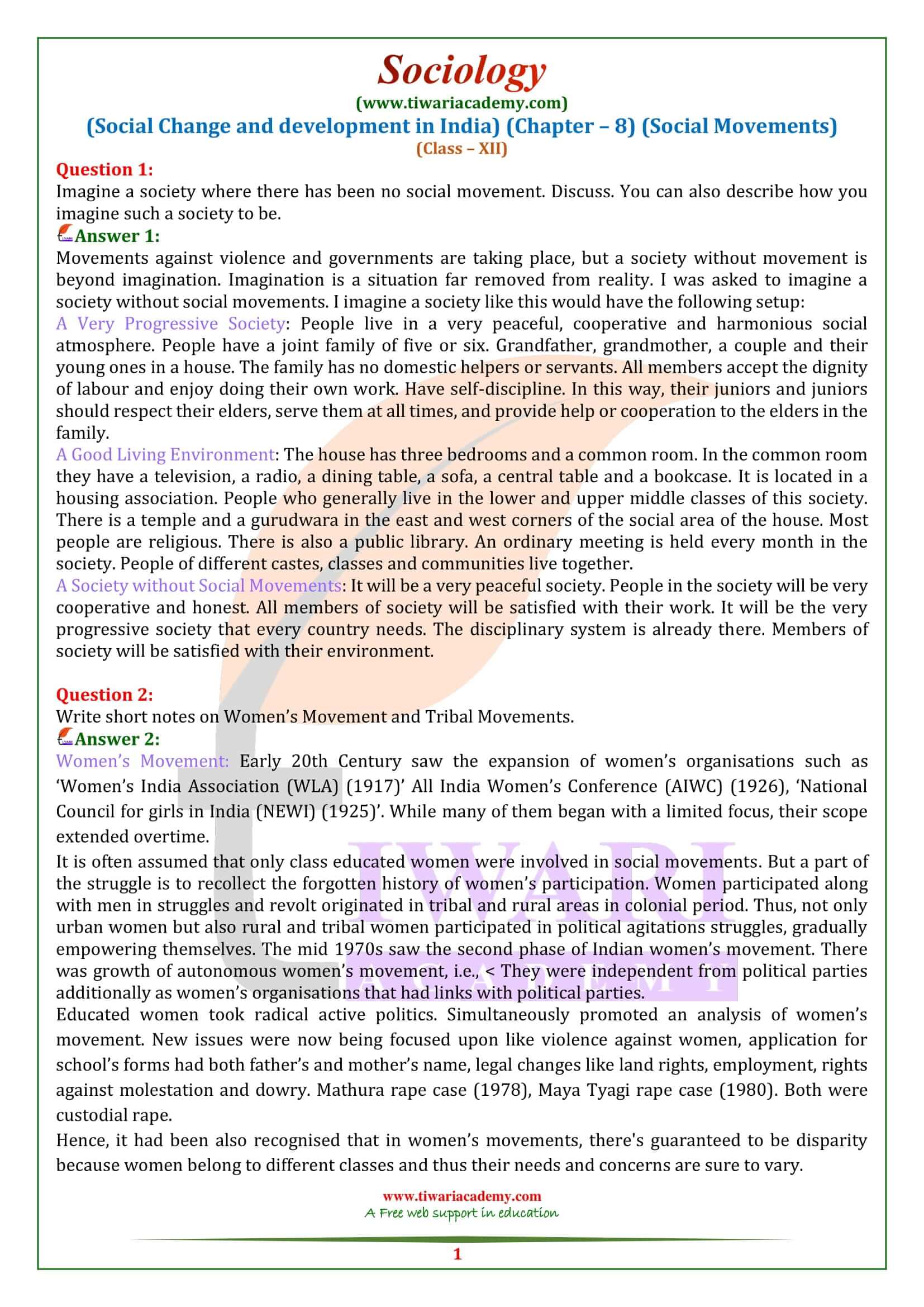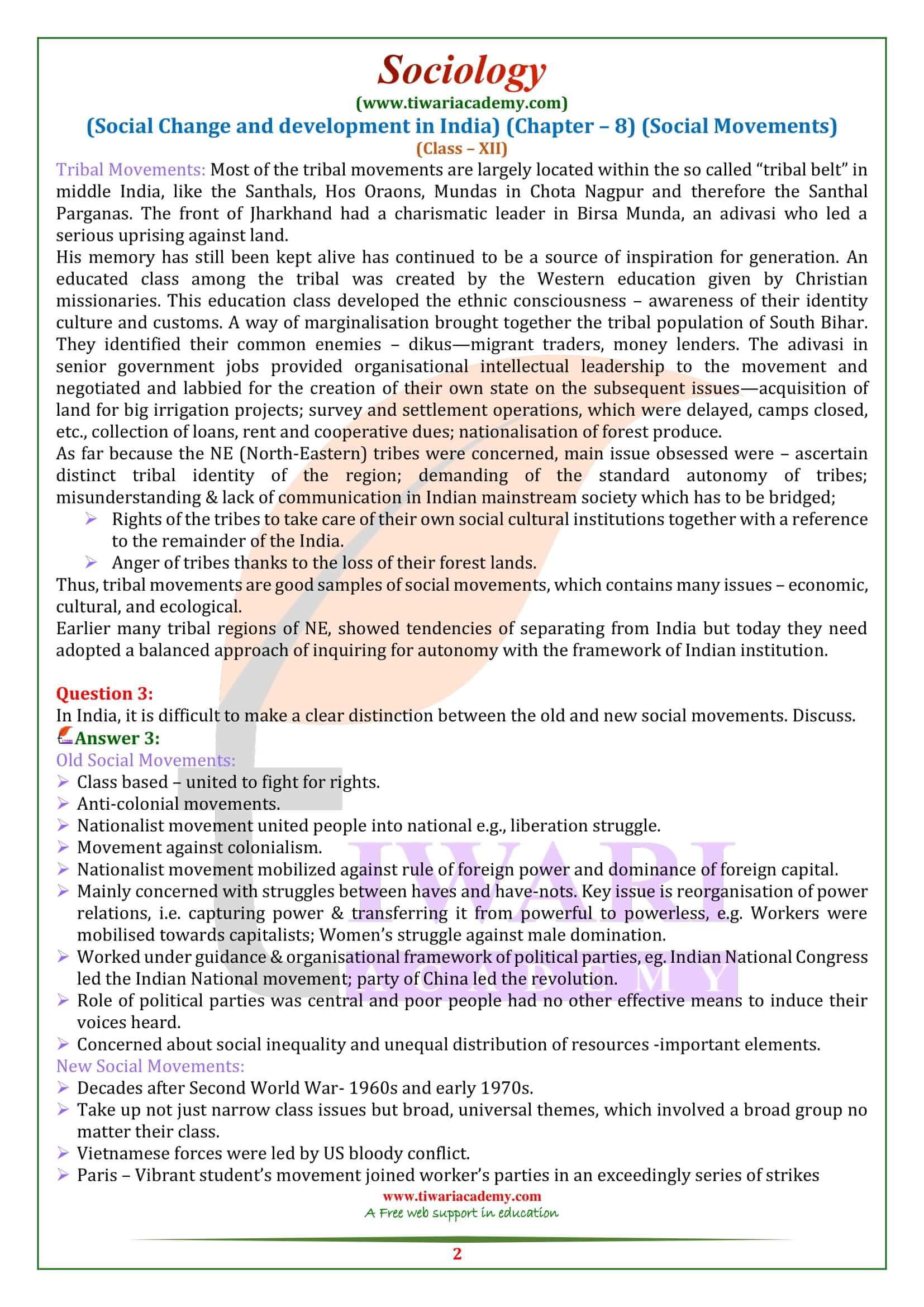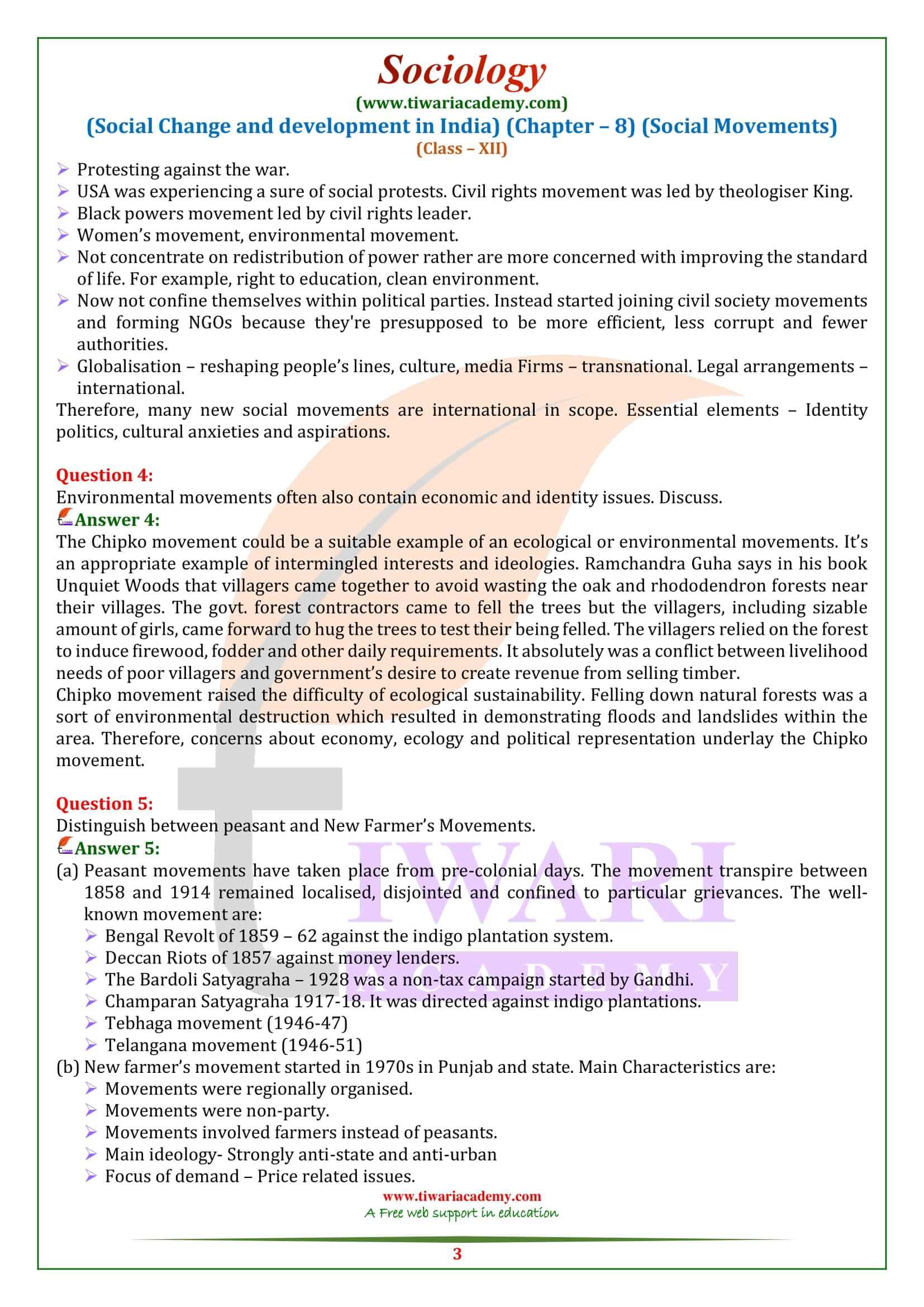NCERT Solutions for Class 12 Sociology Chapter 8 Social Movements in English Medium updated for new academic session 2025-26. All the solutions, MCQ and extra question answers of Class 12 Sociology Part 2 Social Change and Development in India chapter 8 are given in simplified manner.
Class 12 Sociology Chapter 8 Social Movements Question Answers
Imagine a society where there has been no social movement. Discuss. You can also describe how you imagine such a society to be.
Movements against violence and governments are taking place, but a society without movement is beyond imagination. Imagination is a situation far removed from reality. I was asked to imagine a society without social movements. I imagine a society like this would have the following setup:
A Very Progressive Society
People live in a very peaceful, cooperative and harmonious social atmosphere. People have a joint family of five or six. Grandfather, grandmother, a couple and their young ones in a house. The family has no domestic helpers or servants. All members accept the dignity of labour and enjoy doing their own work. Have self-discipline. In this way, their juniors and juniors should respect their elders, serve them at all times, and provide help or cooperation to the elders in the family.
A Good Living Environment
The house has three bedrooms and a common room. In the common room they have a television, a radio, a dining table, a sofa, a central table and a bookcase. It is located in a housing association. People who generally live in the lower and upper middle classes of this society. There is a temple and a gurudwara in the east and west corners of the social area of the house. Most people are religious. There is also a public library. An ordinary meeting is held every month in the society. People of different castes, classes and communities live together.
A Society without Social Movements
It will be a very peaceful society. People in the society will be very cooperative and honest. All members of society will be satisfied with their work. It will be the very progressive society that every country needs. The disciplinary system is already there. Members of society will be satisfied with their environment.
Write short notes on Women’s Movement and Tribal Movements.
Women’s Movement: Early 20th Century saw the expansion of women’s organisations such as ‘Women’s India Association (WLA) (1917)’ All India Women’s Conference (AIWC) (1926), ‘National Council for girls in India (NEWI) (1925)’. While many of them began with a limited focus, their scope extended overtime.
It is often assumed that only class educated women were involved in social movements. But a part of the struggle is to recollect the forgotten history of women’s participation. Women participated along with men in struggles and revolt originated in tribal and rural areas in colonial period. Thus, not only urban women but also rural and tribal women participated in political agitations struggles, gradually empowering themselves. The mid 1970s saw the second phase of Indian women’s movement. There was growth of autonomous women’s movement, i.e., < They were independent from political parties additionally as women’s organisations that had links with political parties.
Educated women took radical active politics. Simultaneously promoted an analysis of women’s movement. New issues were now being focused upon like violence against women, application for school’s forms had both father’s and mother’s name, legal changes like land rights, employment, rights against molestation and dowry. Mathura rape case (1978), Maya Tyagi rape case (1980). Both were custodial rape.
Hence, it had been also recognised that in women’s movements, there’s guaranteed to be disparity because women belong to different classes and thus their needs and concerns are sure to vary.
Tribal Movements: Most of the tribal movements are largely located within the so called “tribal belt” in middle India, like the Santhals, Hos Oraons, Mundas in Chota Nagpur and therefore the Santhal Parganas. The front of Jharkhand had a charismatic leader in Birsa Munda, an adivasi who led a serious uprising against land.
His memory has still been kept alive has continued to be a source of inspiration for generation. An educated class among the tribal was created by the Western education given by Christian missionaries. This education class developed the ethnic consciousness – awareness of their identity culture and customs. A way of marginalisation brought together the tribal population of South Bihar. They identified their common enemies – dikus—migrant traders, money lenders. The adivasi in senior government jobs provided organisational intellectual leadership to the movement and negotiated and labbied for the creation of their own state on the subsequent issues—acquisition of land for big irrigation projects; survey and settlement operations, which were delayed, camps closed, etc., collection of loans, rent and cooperative dues; nationalisation of forest produce.
As far because the NE (North-Eastern) tribes were concerned, main issue obsessed were – ascertain distinct tribal identity of the region; demanding of the standard autonomy of tribes; misunderstanding & lack of communication in Indian mainstream society which has to be bridged.
Rights of the tribes to take care of their own social cultural institutions together with a reference to the remainder of the India.
Anger of tribes thanks to the loss of their forest lands.
Thus, tribal movements are good samples of social movements, which contains many issues – economic, cultural, and ecological.
Earlier many tribal regions of NE, showed tendencies of separating from India but today they need adopted a balanced approach of inquiring for autonomy with the framework of Indian institution.
Environmental movements often also contain economic and identity issues. Discuss.
The Chipko movement could be a suitable example of an ecological or environmental movements. It’s an appropriate example of intermingled interests and ideologies. Ramchandra Guha says in his book Unquiet Woods that villagers came together to avoid wasting the oak and rhododendron forests near their villages. The govt. forest contractors came to fell the trees but the villagers, including sizable amount of girls, came forward to hug the trees to test their being felled.
The villagers relied on the forest to induce firewood, fodder and other daily requirements. It absolutely was a conflict between livelihood needs of poor villagers and government’s desire to create revenue from selling timber.
Chipko movement raised the difficulty of ecological sustainability. Felling down natural forests was a sort of environmental destruction which resulted in demonstrating floods and landslides within the area. Therefore, concerns about economy, ecology and political representation underlay the Chipko movement.
Distinguish between peasant and New Farmer’s Movements.
Peasant movements have taken place from pre-colonial days. The movement transpire between 1858 and 1914 remained localised, disjointed and confined to particular grievances.
The well-known movement are:
- Bengal Revolt of 1859 – 62 against the indigo plantation system.
- Deccan Riots of 1857 against money lenders.
- The Bardoli Satyagraha – 1928 was a non-tax campaign started by Gandhi.
- Champaran Satyagraha 1917-18. It was directed against indigo plantations.
- Tebhaga movement (1946-47)
- Telangana movement (1946-51).
New farmer’s movement started in 1970s in Punjab and state. Main Characteristics are:
- Movements were regionally organised.
- Movements were non-party.
- Movements involved farmers instead of peasants.
- Main ideology- Strongly anti-state and anti-urban
- Focus of demand – Price related issues.




